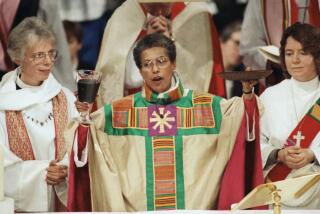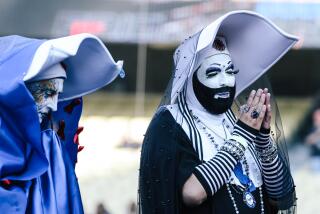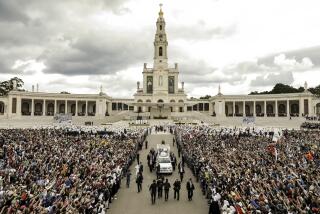Women Celebrate a Christian Heroine
She is widely viewed as a prostitute.
Some historic paintings of her are seen as little more than pious pornography.
She was the sensuous woman depicted as Jesus’ supposed wife in the controversial 1988 motion picture “The Last Temptation of Christ.” She was also portrayed as the harlot who loved Jesus in the 1960s rock musical “Jesus Christ Superstar.”
And she is fast becoming a heroine and feminist role model for women who want a greater role in the Roman Catholic Church.
Her name is Mary Magdalene, among the most prominent women mentioned in the New Testament as followers of Jesus. She was one of the faithful women who kept vigil near the cross and, Gospel accounts say, was the first witness to the resurrection of Jesus--making her an “apostle to the apostles.”
Yet because of centuries of traditional teaching, Mary Magdalene is often remembered as a redeemed harlot--the epitome of both sensuality and spirituality--and proof that sexuality, especially female sexuality, is shameful, sinful and worthy of repentance.
Now, with Roman Catholic, Eastern Orthodox and Episcopal churches observing her saint day this week, a new movement is afoot to rehabilitate her reputation.
In Southern California and across the country, more than 100 groups of lay Christians met in homes, churches and college campuses--in addition to official liturgical observances--to celebrate Mary Magdalene’s life and witness.
For women like Sister Chris Schenk, executive director of the Cincinnati-based FutureChurch, which launched the national observances a year ago, it is not only a question of justice for Mary but a means of affirming an ascendant role for women in churches today.
“We have so few examples of prominent women disciples in the Scriptures that don’t also have something attached that says they’re not quite as good as they should be,” Schenk said. “To have her understood as the ‘apostle to the apostles’ and the first and foremost woman witness--and not as a prostitute--is important . . . to see the visibility of prominent biblical women followers of Jesus because they become role models. Women can see themselves in the gospels too.”
At this point, Schenk said the movement is not focused on the ordination of women, which Pope John Paul II has said the church has no authority to undertake since Jesus did not choose any women as his disciples. Instead, the Mary Magdalene observances are intended to promote broad leadership roles for women throughout the church.
Not that there hasn’t been progress. Women held 46.6% of the professional staff positions in Catholic dioceses in 1998, up from 44.5% in 1995, according to a survey by the U.S. bishops’ Committee on Women in Society and the Church.
But Schenk said traditional teachings like those that describe Mary Magdalene as a redeemed prostitute have made such leadership roles more difficult to obtain.
No one who believes the New Testament accounts of Jesus’ crucifixion and resurrection doubts that Mary Magdalene was the first to see the resurrected Jesus in the garden where his tomb was located.
The problem comes when Mary Magdalene is identified--many say inaccurately--as the unnamed repentant “sinner” mentioned in Luke 7:37-38, who washed Jesus’ feet with her tears and hair earlier in his ministry. A few verses later, in Luke 8:2, her soiled reputation may have been sealed when she was identified by name as a follower of Jesus who at another point had “seven demons” cast out of her. There is another reference to a Mary, the sister of Martha, anointing Jesus’ feet in John 12:3.
Although Eastern Orthodox and Protestant scholarship has long held that various women named Mary were in fact different people, all were conflated into one person--Mary Magdalene--in the Roman Catholic Church at least since Pope Gregory the Great pronounced that the “sinner” who washed Jesus’ feet was Mary Magdalene. Harper’s Bible Dictionary counts seven women in the New Testament named Mary, unless two or more are identical.
Father Thomas Rausch, chairman of the theology department at Loyola Marymount University in Los Angeles, said Luke’s reference to demons has led to speculation that the evil spirits or seven demons had something to do with sex.
The Role of Women
The end result is that Mary Magdalene has borne the reputation as a redeemed harlot. That reputation, women today say, has exacted a price.
“The consequence is that there is no recognition of female leadership in the early church,” said Catherine Wright, a former Catholic nun who now is a priestess in the Temple of Isis, which celebrates and teaches the feminine divine.
Schenk agrees. “Some contemporary scholars believe that the memory of Mary Magdalene as an apostle and a strong woman witness was deliberately replaced with the understanding of her as a prostitute in order to suppress women who were serving in leadership roles in the early church,” said Schenk, who holds a master’s degree in theology and who has studied women in the Bible.
Change is taking place. When Schenk launched her Magdalene project last year, just 25 groups, including five based in Catholic parishes, were involved. She estimated this week that 100 groups were meeting, including 40 parish groups.
The programs consist of a presentation by a biblical scholar about new insights into Mary Magdalene’s life and ministry, followed by a prayer service. But it is often a time to celebrate the role of women in the church.
At All Saints Episcopal Church in Pasadena, for example, more women attended Thursday night’s service than men.
“It’s sort of the feminist opportunity to go all out,” said Anne Peterson, liturgy coordinator at the parish.
Such observances can be empowering.
“Very few women see themselves in the Scriptures. They don’t see themselves visible in the liturgical roles in the church. They don’t hear themselves because God is spoken of in male metaphors,” Schenk said. “My desire was to find a way for women to see ourselves again in Scripture as also called and chosen to proclaim the Gospel, to proclaim Jesus’ Resurrection and presence.”
Patriarchy aside, it remains an uphill fight. Even women involved in the goddess movement often first see Mary Magdalene for her sexuality rather than her leadership role in the early church, according to Wright.
“The first reaction is that this is someone who embodies a healthy sexuality. The sexuality is seen and the liberation is seen, not that it isn’t inherent,” said Wright. But she said it is “very rare” to find women who view Mary Magdalene as having some kind of equality among Jesus’ followers.
Rausch said one of the linchpins of the Vatican’s argument against the ordination of women is that there were no women chosen by Jesus as apostles.
“If you can offer an argument that Mary Magdalene was an apostle in everything but name and that there was some cultural reason for not naming her as an apostle, that disestablishes to a considerable degree the argument of the restriction of the apostolic office to men,” Rausch said.
The Very Rev. Mary June Nestler, dean of the Episcopal School of Theology at Claremont, said that in reading the gospel accounts it is clear that women exercised leadership in the early church.
“Jesus had an association with women that was unusual,” Nestler said. “In his traveling company, the inclusivity of those who heard his message and those invited to hear the message was very strong. Women felt welcomed into his circle at the very least,” she said. “That’s one of the striking things about Jesus’ ministry.”
But she cautioned that it is more difficult to conclude from those accounts that women had “holy orders”--priestly orders--as they are understood today.
The Episcopal Church next Thursday will celebrate the 25th anniversary of the ordination of women in the church. But for now it is enough for Schenk to talk about other kinds of leadership roles for women in the Roman Catholic Church and to hold up Mary Magdalene as a role model.
“I just had a sense that an injustice had been done to this wonderful, strong woman witness,” she said.
More to Read
The biggest entertainment stories
Get our big stories about Hollywood, film, television, music, arts, culture and more right in your inbox as soon as they publish.
You may occasionally receive promotional content from the Los Angeles Times.










